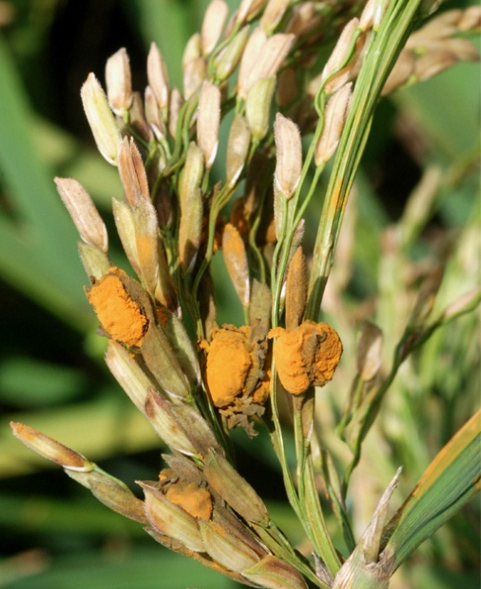Please identify this black ball/glob on nearly-ready-to-harvest rice
Rice Japan
I was in Doshi, Japan (near Mount Fuji area) with my family yesterday. We were hiking through numerous rice fields and several I observed had these black balls attached to them, throughout the entire field. Other fields did not have them at all. I'd like to know what they are - the rice otherwise on the rest of the plant looked fine. I'm concerned that whatever these are will not be separated out of the edible rice when the rice is harvested.
Posted
by: Stephen Reimers
(1 point)
![]()
Posted: September 10, 2017
Answers
Hi Stephen
This is a fungus called Rice False Smut that affects the pannicle of the rice. The disease is caused by a fungus Ustilaginoidea virens
U. virens produces a toxin, known as Ustiloxin. The toxins cause mycotoxicosis and inhibit the polymerization of brain tubulin at micromolar concentrations. It is known that the presence of the fungus reduces rice yields but I havent seen how (or if) the toxin can be removed.
Here is a nice fact sheet http://www.rkmp.co.in/sites/default/f...
And below some text from a report of the Government of Cambodia
http://www.plantwise.org/KnowledgeBan...
"Rice False Smut
Recognize the problem
Outbreaks of false smut generally occur during periods of high humidity. Normally only a few grains in a panicle are affected and the attack usually takes place when the grains are mature. The fungus transforms individual rice grains into large spherical balls containing spores. These spore balls are initially orange, then change to yellowish-green and turn greenish-black when mature. In most cases, not all spikelets of a panicle are affected, but spikelet’s neighboring smut balls are often unfilled.
Background
The disease can occur in areas with high relative humidity (>90%) and temperature ranging from 25-35°C. Rain and high humidity, and soils with high nitrogen content also favor disease development. Wind can spread the fungal spores from plant to plant. False smut is visible only after panicle initiations. It can also infect the plant during flowering stage.
Management
Keep the field clean.
Remove infected seeds, panicles, and plant debris after harvest.
Cultivate unflooded rice (e.g. furrow irrigation) to reduce the disease
Where possible, perform conservation tillage
Use moderate rates of nitrogen
Use certified seeds. (get from reliable suppliers)
Treat seeds at 52°C for 10 min.
For fields with high incidence of false smut spray or dust with recommended fungicides a few days before heading.
When using a pesticide, always wear protective clothing and follow the instructions on the product label, such as dosage, timing of application, and pre-harvest interval."
This is a fungus called Rice False Smut that affects the pannicle of the rice. The disease is caused by a fungus Ustilaginoidea virens
U. virens produces a toxin, known as Ustiloxin. The toxins cause mycotoxicosis and inhibit the polymerization of brain tubulin at micromolar concentrations. It is known that the presence of the fungus reduces rice yields but I havent seen how (or if) the toxin can be removed.
Here is a nice fact sheet http://www.rkmp.co.in/sites/default/f...
And below some text from a report of the Government of Cambodia
http://www.plantwise.org/KnowledgeBan...
"Rice False Smut
Recognize the problem
Outbreaks of false smut generally occur during periods of high humidity. Normally only a few grains in a panicle are affected and the attack usually takes place when the grains are mature. The fungus transforms individual rice grains into large spherical balls containing spores. These spore balls are initially orange, then change to yellowish-green and turn greenish-black when mature. In most cases, not all spikelets of a panicle are affected, but spikelet’s neighboring smut balls are often unfilled.
Background
The disease can occur in areas with high relative humidity (>90%) and temperature ranging from 25-35°C. Rain and high humidity, and soils with high nitrogen content also favor disease development. Wind can spread the fungal spores from plant to plant. False smut is visible only after panicle initiations. It can also infect the plant during flowering stage.
Management
Keep the field clean.
Remove infected seeds, panicles, and plant debris after harvest.
Cultivate unflooded rice (e.g. furrow irrigation) to reduce the disease
Where possible, perform conservation tillage
Use moderate rates of nitrogen
Use certified seeds. (get from reliable suppliers)
Treat seeds at 52°C for 10 min.
For fields with high incidence of false smut spray or dust with recommended fungicides a few days before heading.
When using a pesticide, always wear protective clothing and follow the instructions on the product label, such as dosage, timing of application, and pre-harvest interval."
Posted
by: David Hughes
(67 points)
![]()
Posted: September 11, 2017
Stephen Reimers commented,
David, I think that hits the nail right on the head. Thanks SO much. That second photo was the clincher - looks like these "smut-balls" have gone through all the stages and are about to rupture and spread more disease everywhere. Thanks again for the good research! over 6 years ago.
David, I think that hits the nail right on the head. Thanks SO much. That second photo was the clincher - looks like these "smut-balls" have gone through all the stages and are about to rupture and spread more disease everywhere. Thanks again for the good research! over 6 years ago.
You need to log in if you'd like to add an answer or comment.






this is fungus disease casual organism is ustilaginoidea virens ,in this disease indivisual rice grain converted into yellowing fruit bodies,but only few grains in panicles are infected and rest are normal
management-propiconazole 25EC @500 ml/ha or copper hydroxide 77wp@1.25kg/ha ... over 6 years ago.